七、Shell 流程控制
7.1 if
bash
#!/bin/bash
num1=100
if test $[num1] == 100
then
echo 'num1 是 100'
fi
7.2 if else
bash
#!/bin/bash
num1=100
num2=100
if test $[num1] -eq $[num2]
then
echo '两个数相等!'
else
echo '两个数不相等!'
fi
7.3 if else-if else
bash
#!/bin/bash
a=10
b=20
if [ $a == $b ]
then
echo "a 等于 b"
elif [ $a -gt $b ]
then
echo "a 大于 b"
elif [ $a -lt $b ]
then
echo "a 小于 b"
else
echo "没有符合的条件"
fi
7.4 for
bash
#!/bin/bash
for loop in 1 2 3 4 5
do
echo "The value is: $loop"
done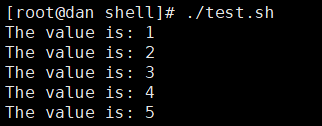
7.5 while
bash
#!/bin/bash
int=1
while(( $int<=5 ))
do
echo $int
let "int++"
done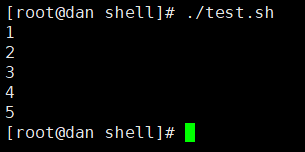
7.6 until
bash
#!/bin/bash
a=0
until [ ! $a -lt 10 ]
do
echo $a
a=`expr $a + 1`
done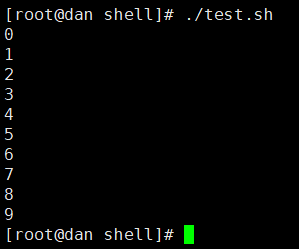
7.7 case ... esac
bash
echo '输入 1 到 4 之间的数字:'
echo '你输入的数字为:'
read aNum
case $aNum in
1) echo '你选择了 1'
;;
2) echo '你选择了 2'
;;
3) echo '你选择了 3'
;;
4) echo '你选择了 4'
;;
*) echo '你没有输入 1 到 4 之间的数字'
;;
esac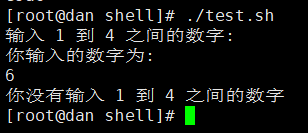
7.8 break
break 命令允许跳出所有循环(终止执行后面的所有循环)
7.9 continue
continue 命令与 break 命令类似,只有一点差别,它不会跳出所有循环,仅仅跳出当前循环
八、Shell 函数
8.1 定义函数
bash
#!/bin/bash
demoFun(){
echo "这是我的第一个 shell 函数!"
}
echo "-----函数开始执行-----"
demoFun
echo "-----函数执行完毕-----"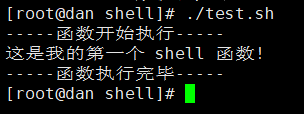
8.2 函数参数
bash
#!/bin/bash
funWithParam(){
echo "第一个参数为 $1 !"
echo "第二个参数为 $2 !"
echo "第十个参数为 $10 !"
echo "第十个参数为 ${10} !"
echo "第十一个参数为 ${11} !"
echo "参数总数有 $# 个!"
echo "作为一个字符串输出所有参数 $* !"
}
funWithParam 1 2 3 4 5 6 7 8 9 34 73
九、Shell 输入/输出重定向
| 命令 | 说明 |
|---|---|
| command > file | 将输出重定向到 file。 |
| command < file | 将输入重定向到 file。 |
| command >> file | 将输出以追加的方式重定向到 file。 |
| n > file | 将文件描述符为 n 的文件重定向到 file。 |
| n >> file | 将文件描述符为 n 的文件以追加的方式重定向到 file。 |
| n >& m | 将输出文件 m 和 n 合并。 |
| n <& m | 将输入文件 m 和 n 合并。 |
| << tag | 将开始标记 tag 和结束标记 tag 之间的内容作为输入。 |
9.1 输出重定向

**注意:**输出重定向会覆盖文件内容
9.2 输入重定向

9.3 重定向深入讲解
重定向符号
>:输出重定向,用于将命令的标准输出重定向到文件。会覆盖文件内容。>>:追加重定向,用于将命令的标准输出追加到文件末尾。<:输入重定向,用于将文件内容重定向为命令的标准输入。2>:错误重定向,用于将命令的标准错误重定向到文件。会覆盖文件内容。2>>:错误追加重定向,用于将命令的标准错误追加到文件末尾。&>:将标准输出和标准错误一起重定向到文件。会覆盖文件内容。&>>:将标准输出和标准错误一起追加到文件末尾。
文件描述符重定向
文件描述符是内核用来访问文件的引用。默认情况下:
- 标准输入的文件描述符是 0
- 标准输出的文件描述符是 1
- 标准错误的文件描述符是 2
我们可以使用文件描述符进行更复杂的重定向操作。

bash
[root@dan shell]# cat users who_is_the_best_in_the_world > output.txt 2> error.txt
[root@dan shell]# cat output.txt
root tty2 2024-06-27 17:24 (tty2)
root pts/0 2024-06-27 17:28 (192.168.0.120)
root pts/1 2024-06-28 12:22 (192.168.0.120)
Cao Licheng is the best in the world
[root@dan shell]# cat error.txt
[root@dan shell]# cat users 666 > output.txt 2> error.txt
[root@dan shell]# cat error.txt
cat: 666: No such file or directory
[root@dan shell]# 第二次查询了一个不存在文件,并将错误输出到了 error.txt 文件中
9.4 Here Document
Here文档是一种将多行字符串作为命令输入的方法,常用于脚本中
bash
cat << EOF
This is a here document.
It can contain multiple lines of text.
EOF上述命令将多行文本作为 cat 命令的输入,EOF 是结束符,可以用其他字符串替换,但需要保持一致
9.5 /dev/null 文件
如果希望执行某个命令,但又不希望在屏幕上显示输出结果,那么可以将输出重定向到 /dev/null:
bash
$ command > /dev/null十、Shell 文件包含
test2.sh 代码如下
bash
#!/bin/bash
url="https://eclecticism.blog.csdn.net/"test1.sh 代码如下
bash
#!/bin/bash
source ./test2.sh # 或者 . ./test2.sh
echo "博客地址:${url}"